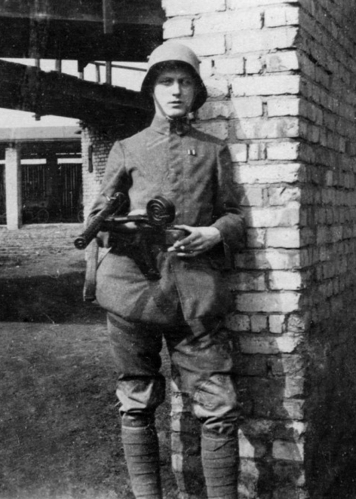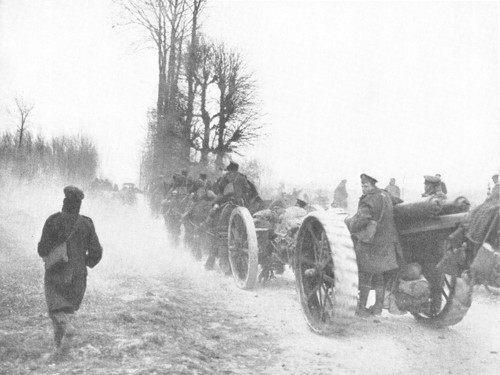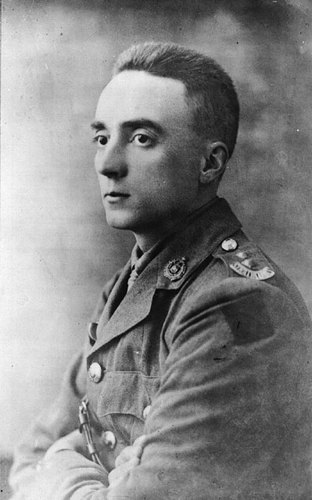21 March 2023
Operation Michael: How Imperial Germany tried to win World War One (and how it failed)
On March 21st, 1918, the Imperial German Army launched a massive offensive in an attempt to finally win World War One: Operation Michael.
Operation Michael
The state of the Western Front in March 1918

Even in early 1918, no major breakthrough had yet to occur on The Western Front (Wikimedia Commons)
Since August 1914, Imperial Germany had vying for control of the French & Belgium battlefields with Great Britain and its Empire, France, Belgium, and their allies.
For the bulk of that time, it was the Entente Powers of France and Britain that had been on the offensive. Germany's war had been mostly defensive since 1915.
The once green and pleasant countryside they were fighting in had been turned into a blasted hellscape of trenches, barbed wire, and No Man’s Land.
Europe’s youth was being bled and trampled into the dirt. A generation of young men had been wiped out.
Titanic clashes on the Somme, Arras, Passchendaele, Cambrai, Ypres, Verdun, and more iconic Great War locations claimed many lives.
Despite millions of casualties on either side and some territorial gains, no army had been able to make a decisive breakthrough and win the war.
On 11th November 1917, German High Command began planning what they hoped would be the campaign that would win them the war.
Planning would continue into the early months of 1918. It was decided March would be the time to launch the decisive blow under the ambitious Spring Offensive.
The Spring Offensive

A map of the major German offensives of 1918. The Spring Offensive and its four phases occurred early in the year (Wikimedia Commons)
Several factors forced General Ludendorff and the other German war leaders into going on the offensive for the first time since 1915.
- At home, the German people were close to starvation thanks to the Royal Navy’s blockade of German ports. Civilians who had lost sons, nephews, husbands, brothers, fathers, and cousins were growing tired of war.
- Russia had sued for peace following the 1917 October Revolution. With Russia out of the war, German High Command was able to transfer 50 divisions from the Eastern Front to the West, increasing their available manpower.
- The United States had entered the war. Nearly 320,000 fresh troops were expected to land in France in May 1918 with a million more due to arrive in August. If the war wasn’t won soon, the US’ manpower and industrial might would provide an overwhelming advantage to the Allies.
- Ludendorff and his Generals thought the British Expeditionary Force was weakening following the huge battles of 1917.
It was decided that the German Army would launch its Spring Offensive, also known as the Kairserschlacht (Kaiser’s Battle) in March 1918.
A new class of elite soldiers, the Stormtroopers, had been trained in infiltration and breakthrough tactics to smash the Allied lines.
These highly mobile submachine-equipped units would form the German spearhead once the Spring Offensive began.
The Spring Offensive was split into four distinct phases: Michael, Georgette, Gneisenau and Blücher-Yorck.
With these four hammer blows, German High Command hoped to finally win the war.
What was Operation Michael?
 Image: An elite German Stormtrooper, the vanguard of Operation Michael (Wikimedia Commons)
Image: An elite German Stormtrooper, the vanguard of Operation Michael (Wikimedia Commons)
Operation Michael was the first phase of the Spring Offensive.
Its target was British and Commonwealth positions along the Somme.
The Third and Fifth British Armies were the southernmost British formations on the Western Front at that time, holding positions near the important cities of Amiens and Arras, as well as near Cambrai.
Cambrai had been made famous in 1917 as the site of the world’s first mass tank attack.
The French held the line to the south of the British positions.
Under Operation Michael, German forces would attack the BEF to split the Allied lines.
The idea was to force a British retreat, after putting pressure on their supply lines, which would cause the French to fall back to protect Paris. After this, German forces would press north to force Britain out of France once and for all and induce a final French surrender.
With the introduction of divisions from the east, the Imperial German Army initially held a strong numerical advantage.
Three German armies had been assembled to launch Operation Michael with a total of 65 divisions and over 6,600 artillery guns. Around 800,00 men had been assembled, poised to wipe away the British and Commonwealth troops in front of them in a storm of steel.
The opposing BEF forces had just over 3,300 guns but only 26 divisions.
Despite over 500,000 soldiers, including Canadians, Australian, and New Zealand troops, manning the line on the Somme, only 180,000 British and Commonwealth forces were in the main German attack zone.
One of the most important locations defended by the British Somme positions was the city of Amiens.
Holding Amiens was vital for continued British presence in the area. Almost all the supplies destined for the southern British sector flowed through the city. Amiens was also a major communications centre. It had to be protected at all costs.
The ground German and British forces would be fighting on had already seen bloodshed. In 1916, the infamous Battle of the Somme was fought here, featuring the worst day in British military history.
Although British intelligence knew an attack was on its way, generals were unaware of the scale or ferocity of Operation Michael.
Would Michael prove as disastrous for the British as the First Day of the Somme?
Operation Michael begins

German Stormtroopers attack across No Man's Land (Wikimedia Commons)
4.40 am on the 21st of March 1918.
A thick mist blankets No Man’s Land. Visibility is poor across the front. German soldiers use the misty cover to begin their advance undetected.
Suddenly, the early morning sky is rent asunder with thunder flashes and spits of flame. Across a 46-mile front, 6,600 German guns opened fire.
The barrage lasts for a harrowing five hours, raining an incredible 3.5 million shells down on British positions.
Once the main artillery pounding ceased, a creeping barrage began, covering the German infantry advance.
The Stormtroopers were in the vanguard. Lighting speed, impeccable training, and dogged determination made them incredibly deadly.
Moving in small, separated groups, Stormtrooper squads were able to bypass British defences, moving through the lines to cut them off at the rear.
Along the British line, outposts were cut off with the defenders overwhelmed and cut down in large numbers.
Casualties were high.
Sixteen dangerous days on the Somme
German forces hit the beleaguered British Fifth Army hard.
While they would eventually recover and reorganise, it would take the Allies 16 long days of fighting to see off the German assault.
A spirited resistance helped slow the German advance, slowing the Seventeenth and Second Imperial Germany Armies down to a crawl.
However, the British were still on the back foot. The BEF continued to give ground.
Encouraged by his successes against the British Fifth Army, Ludendorff refocused on the BEF’s Eighteenth Army.
The Eighteenth was better organised and, despite continuing to fall back, began to inflict heavy punishment on the Germans.
As the German advance deepened, the Stormtroopers were soon at the very edge of their supply lines but still, they pressed on.
 Image: British troops retreat in the wake of the Imperial German onslaught (Wikimedia Commons)
Image: British troops retreat in the wake of the Imperial German onslaught (Wikimedia Commons)
As the British retreated across the Somme, a collapse was a very real possibility.
Chains of command had been disrupted. Units intermingled and merged with one another in the confusion. If gaps appeared in the line, German forces could exploit them.
Several Allied-held towns had been captured, including Albert, Bapaume and Pèronne.
The Fifth Army continued to take a battering but, despite its proximity east of Amiens, the British were able to give ground here. To the north, which Third Army was defending, lay the routes to the vital Channel ports.
As important as Amiens was if the Germans captured ports like Calais, the flow of Allied men and material into France would cease instantly. That simply could not happen.
Slowly, the British began to push back.
On the 26th, British and French forces were reorganised under a single commander under a joint High Command.
General Ferdinand Foch used his newfound authority to order French reinforcements to aid the ailing BEF.
As French troops entered the Somme, Ludendorff and the Germans changed tack. He swung his forces north, ordering the Stormtroopers and Seventeenth Army to attack Arras under Operation Mars.
The forces arrayed at Arras were able to beat back this attack. Operation Mars petered out as the British Third Army, which had been better reinforced than their counterparts in the Fifth, held firm.
Even so, the Fifth fought a ferocious rear-guard action around Arras to slow the Germans. With no reserves and no strong fall-back position, it contested every town, village, field, and square to defend the city.
On 4th April, Ludendoff once more changed Operation Michael’s objectives. This time, Eighteenth Army was ordered back south with Amiens as the prize.
Once more the attack failed. Amiens held.
After sixteen days of some of the most desperate fighting of World War One, Operation Michael was over.
Was Operation Michael a success?

German troops advance across the Somme. Despite taking a huge amount of ground, the Germany Army was unable to hold it (Wikimedia Commons)
Operation Michael was one of the most shocking operations of the Great War when it was launched in March 1918.
By the end of the fighting on April 5th, the Germans had captured 1,200 square miles of ground – the most captured since stalemate hit the Western Front toward the end of 1914 - advancing 40 miles in just 16 days.
However, while they took masses of ground, the Imperial German Army could not achieve its desired knockout blow.
Ultimately, Operation Michael failed in its key objective. Britain and France were both still very much in the war. The United States could also continue to land men and materiel in France.
Germany’s days were numbered.
Why did Operation Michael fail?
Historians and observers attribute the failure of Operation Michael down to several factors:
- Ludendorff kept switching objectives which caused disruption to supply lines and reinforcements.
- The German armies involved in the operation moved away from one another as they advanced, rather than moving towards a single point to increase their combat power.
- Amiens’ importance was not realised until too late in the battle as the Germans focused on defeating the British in the field instead of targeting their logistics.
- A lack of cavalry to harass the retreating British meant the BEF could fall back faster than the Germans could advance.
- Even so, German forces still outran their supply lines and were too easily cut off.
- While Stormtroopers used elite, complex tactics, the bulk of the German forces were regular infantry, which were an easier proposition for the Allies to handle.
- German losses were just as heavy as their opponents’ even with an initial overwhelming numerical advantage.
Casualties of Operation Michael
Operation Michael was a major World War One offensive. Heavy casualties were par for the course for such operations.
On the 21st of March, the BEF casualties numbered 38,500 killed, captured, wounded, or missing. Some 21,000 soldiers were taken prisoner. Only the disastrous First Day of the Somme on the 1st of July 1916 had been a worse day for the British Army.
Total casualties for Operation Michael stand at around 240,000 for the Imperial German Army. Combined British and French casualties came to 250,000.
Captain Gordon Flowerdew VC
 Image: Captain Gordon Flowerdew won the Victoria Cross for his gallant actions during Operation Michael (Wikimedia Commons)
Image: Captain Gordon Flowerdew won the Victoria Cross for his gallant actions during Operation Michael (Wikimedia Commons)
Norfolk-born Gordon Flowerdew had emigrated to Canada at 18, working as a rancher in British Colombia.
He was a talented horseman, so it was only natural he joined the Canadian Cavalry Brigade when World War One broke out in 1914.
Gordon earned an officer commission in 1916 and was given command of his own cavalry squadron, C Squadron, in 1918, just ahead of Operation Michael.
Life for the Canadian Cavalry Brigade on the Western Front had been relatively quiet for most of the war. That would all change when Operation Michael was launched.
Even in the age of machine guns and tanks, cavalrymen like Gordon Flowerdew had an important battlefield role to play.
On 30th March, the German advance reached Moreuil Wood, south of Amiens. The Canadian Cavalry had skirted the woods as German infantrymen made their way through the area, setting up for an attack.
Gordon was given the order and the men of C Squadron, swords flashing, crashed into the German line.
C Squadron managed to break through two German lines before wheeling away and charging back to safety.
Ultimately, the Germans were held at Moreuil Woods but the cost for C Squadron had been high. The unit had lost 70% of its strength killed or wounded. Captain Flowerdew was amongst them.
Gordon had been hit in both legs and died at a casualty clearing station on 31st March 1918 aged 33.
For his courage and leadership during the fighting at Moreuil, Gordon was awarded the Victoria Cross, Britain’s highest military honour.

Charge of Flowerdew's Squadron, 1918 by Alfred Munnings (Canadian War Museum)
Gordon’s VC citation reads:
“For most conspicuous bravery and dash when in command of a squadron detailed for special services of a very important nature.
On reaching his first objective, Lieutenant Flowerdew saw two lines of enemy, each about sixty strong, with machine guns in the centre and flanks; one line being about two hundred yards behind the other.
Realizing the critical nature of the operation and how much depended on it, Lieut. Flowerdew ordered a troop under Lieut. Harvey, VC, to dismount and carry out a special movement, while he led the remaining three troops to the charge.
The squadron (less one troop) passed over both lines, killing many of the enemy with the sword; and wheeling about galloping on them again.
Although the squadron had then lost about 70 per cent of its members, killed and wounded from rifle and machine gun fire directed on it from the front and both flanks, the enemy broke and retired.
The survivors of the squadron then established themselves in a position where they were joined, after much hand-to-hand fighting, by Lieut. Harvey's part.
Lieut. Flowerdew was dangerously wounded through both thighs during the operation but continued to cheer his men. There can be no doubt that this officer's great valour was the prime factor in the capture of the position.”
Captain Gordon Flowerdew is buried in Namps-Au-Val British Cemetery.
Cemeteries & memorials of Operation Michael
Several Commonwealth War Graves Commission cemeteries and memorials commemorate Commonwealth casualties of Operation Michael. Each has its own story. Here is a small selection of them.

Arras Memorial
The countryside around Arras is replete with CWGC cemeteries and memorials. There are locations within the city limits too, such as the Arras Memorial.
Over 9,000 casualties of Operation Michael with no known grave are commemorated on its panels.
Fighting raged around the city during late March 1918, with the town’s defenders driving back their German opponents at a heavy cost to halt Operation Mars.

Pozieres Memorial
More than 12,740 servicemen who died during Operation Michael who have no known grave are commemorated on the Pozieres Memorial.
Pozieres stands in the heart of the Somme battlefields. These saw terrible fighting and loss of life in both 1916 and 1918.
The peaceful green fields of the region belie the shell-scarred landscape soldiers would have seen as Operation Michael raged.

Doullens Communal Cemetery Extension No.1
Doullens was the site of an important Allied headquarters and medical facility during World War One.
The 2/1st Northumbrian Casualty Clearing Station at Doullens handled many wounded servicemen during Operation Michael, as did the 3rd Canadian Stationary Hospital.
Today, Extension No.1 holds 540 Commonwealth burials from the battle.
Other cemeteries & memorials holding Operation Michael casualties include:
- Ham British Cemetery – Contains 200 identified servicemen and many unknown soldiers believed to date from Operation Michael.
- Noyon – Contains approximately 140 soldiers from the battle.
- Pargny British Cemetery – Contains over 120 identified Operation Michael casualties and more unknown soldiers.
- Savy British Cemetery – Isolated burials and those from smaller cemeteries were concentrated into Savy British Cemetery following the 1918 Armistice.
- Chauny Communal Cemetery British Extension – The British Extension at Chauny is the final resting place of 250 identified servicemen who fell in Operation Michael.
- Beaumetz-Les-Cambrai Military Cemetery No.1 – 75 identified service personnel are buried here, with casualties from the 51st (Highland) and 25th Divisions’ tenacious defence of the Bapaume-Cambrai road buried here.
Discover more about the men & women CWGC commemorates with our search tools
Our search tools can help you uncover more stories of those commemorated by the Commonwealth War Graves Commission.
Use our Find War Dead tool to search for specific casualties by name, where they served, which branch of the military they served in, and more parameters.
Looking for a specific location? Use our Find Cemeteries & Memorial search tool to find all our sites. You can search by country, locality, and conflict.

